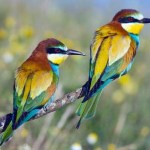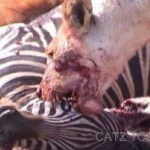conservation
tags: Tree of Life, conservation, biodiversity, ecology, evolution, biology, statistics, teaching, streaming video
This video presents a very brief glimpse into what I do as a professional researcher studying "my birds" -- the parrots of the South Pacific Ocean (during those rare and beautiful times when I actually have a job!!). To say the least, it fills me with intense longing to reclaim my long lost life.
One of the most famous of 'missing' birds is the elusive Night parrot, an obscure nocturnal species discovered by John McDouall Stuart in 1845 (though not named until 1861). Small, reluctant to fly, highly nomadic and cryptically coloured, it's never been well known and even now there are only 23 or so specimens in collections. You might know the Night parrot as Geopsittacus occidentalis but many ornithologists now regard it as so close to the Ground parrot Pezoporus wallicus that both are included within the same genus (and Pezoporus Illiger, 1811 is older than Geopsittacus Gould, 1861).
By…
tags: Birds in the News, BirdNews, ornithology, birds, avian, newsletter
"Magpie Menace"
Pete Marshall, 2009, Oil [larger view].
Birds in Science
By genetically modifying the brains of songbirds for the first time, scientists may have a devised useful new tool for studying neurological growth and healing in humans. "Songbirds have become a classic tool for studying vocal learning and neuron replacement. This will bring those two topics into the molecular age," said neuroscientist Fernando Nottebohm of Rockefeller University, author of a study published recently in the Proceedings of the…
tags: kakapo, Strigops habroptilus, conservation, endangered species, humor, Stephen Fry, Mark Carwardine, Last Chance to See, streaming video
Stephen Fry and zoologist Mark Carwardine head to the ends of the earth in search of animals on the edge of extinction.
In New Zealand the travellers make their way through one of the most dramatic landscapes in the world. They are on a journey to find the last remaining kakapo, Strigops habroptilus, a fat, flightless parrot which, when threatened with attack, adopts a strategy of standing very still indeed.
This behavior is not uncommon among birds…
tags: Tree of Life, conservation, biodiversity, ecology, evolution, biology, statistics, teaching, streaming video
This video presents a very brief glimpse into what I do as a professional researcher studying "my birds" -- the parrots of the South Pacific Ocean (during those rare and beautiful times when I actually have a job!!). It features interviews with one of the scientists whom I worked with when I was in grad school at the University of Washington: Scott Edwards, who now is at Harvard University. To say the least, this video fills me with intense longing to reclaim my long lost life…
This article is reposted from the old Wordpress incarnation of Not Exactly Rocket Science. The blog is on holiday until the start of October, when I'll return with fresh material.
It's a myth that elephants are afraid of mice, but new research shows that they're not too keen on bees. Even though they fearlessly stand up to lions, the mere buzzing of bees is enough to send a herd of elephants running off. Armed with this knowledge, African farmers may soon be able to use strategically placed hives or recordings to minimise conflicts with elephants.
Iain Douglas-Hamilton and Fritz Vollrath…
tags: Birds in the News, BirdNews, ornithology, birds, avian, newsletter
Fiji (MacGillivray's) Petrel, Pseudobulweria macgillivrayi, off Gau Island, Fiji.
Fiji Petrel Pelagic Expedition, May 2009.
Image: H. Shirihai, Tubenoses Project [larger view].
Birds in Science News
Maori legends told of a giant predatory bird called the Te Hokioi, whose wingspan approached the length of a full-grown man and whose prey included human beings. Now Kiwi scientists are adding to the legend by claiming that a skeleton found in the 1870s shares some of the legendary bird's traits. "We don't think it…
tags: conservation, environmentalism, global warming, ocean acidification, AMNH, American Museum of Natural History, New York City, A Sea Change, film premier
Image: A Sea Change [larger view].
Can you imagine oceans that have been emptied of all fish? What would life be like for other life forms on this planet if there really were no more fish in the sea? This is not science fiction: human-caused ocean acidification is already making its effects known. Sometimes known as the "wet underbelly" or "evil twin" of climate change, ocean acidification is caused by excess carbon dioxide from…
tags: conservation, environmentalism, global warming, ocean acidification, AMNH, American Museum of Natural History, New York City, A Sea Change, film premier
Image: A Sea Change [larger view].
Can you imagine oceans that have been emptied of all fish? What would life be like for other life forms on this planet if there really were no more fish in the sea? This is not science fiction: human-caused ocean acidification is already making its effects known. Sometimes known as the "wet underbelly" or "evil twin" of climate change, ocean acidification is caused by excess carbon dioxide from…
tags: conservation, environmentalism, global warming, ocean acidification, AMNH, American Museum of Natural History, New York City, A Sea Change, film premier
Image: A Sea Change [larger view].
Can you imagine oceans that have been emptied of all fish? What would life be like for other life forms on this planet if there really were no more fish in the sea? This is not science fiction: human-caused ocean acidification is already making its effects known. Sometimes known as the "wet underbelly" or "evil twin" of climate change, ocean acidification is caused by excess carbon dioxide from…
tags: parrots, Kakapo, Strigops habroptilus, BBC Two, Last Chance to See, endangered species, BBC Two, Mark Carwardine, Stephen Fry, streaming video
Parrot lovers will especially enjoy this video, but anyone who enjoys birds and who wishes to protect endangered species will like it also. Following in the footsteps of Douglas Adams, Stephen Fry joins Mark Carwardine to travel to some of the most remote places on earth in search of endangered animals. In this case, he meets a Kakapo, Strigops habroptilus, a round, sweet-smelling green parrot that lives in New Zealand.
You might also be…
tags: conservation, environmentalism, global warming, ocean acidification, AMNH, American Museum of Natural History, New York City, A Sea Change, film premier
Image: A Sea Change [larger view].
Can you imagine oceans that have been emptied of all fish? What would life be like for other life forms on this planet if there really were no more fish in the sea? This is not science fiction: human-caused ocean acidification is already making its effects known. Sometimes known as the "wet underbelly" or "evil twin" of climate change, ocean acidification is caused by excess carbon dioxide from…
As the long days of late summer grow shorter and darker, many of us are trying to eke out as much time outdoors as possible before fall's sweaters and yellowing leaves arrive. ScienceBloggers are no exception this week as they took to the natural world, focusing the lens of science on wildlife. Greg Laden's Blog looks to the skies, reporting on BirdLife International's efforts to "confirm the continued existence of 47 species of bird that have not been seen for up to 184 years." Photo Synthesis takes a dive into the deep, showcasing a photo essay on the sea's most fascinating camouflaged…
tags: Birds in the News, BirdNews, ornithology, birds, avian, newsletter
Sandwich Tern, Sterna sandvicensis, photographed at the Bolivar Ferry, Texas.
Image: Joseph Kennedy, 4 August 2009 [larger view].
Birds and Technology
Rather than searching for weird weather or enemy missiles, some satellites are helping researchers to track -- and predict -- the spread of deadly diseases. With the pandemic spread of H1N1 swine flu and the continued advance of the H5N1 avian flu, scientists are anxious to better predict the spread of infectious diseases and are looking for new tools wherever they…
tags: US endangered species list, parrots, aviculture, captive breeding, position statement, Parrots International, politics
NOTE: This position statement just came to my attention. I wish I had learned about it on 10 August, since I would have shared it immediately on that day.
August 10, 2009
Public Comments Processing
Attn: FWS-R9-IA-2009-0016
Division of Policy and Directives Management
U.S. Fish and Wildlife Service
4401 N. Fairfax Drive
Suite 222; Arlington, VA 22203
As president of Parrots International I am forwarding the official position statement of Parrots International in…
This article is reposted from the old Wordpress incarnation of Not Exactly Rocket Science.
Getting excited when fish produce sperm would usually get you strange looks. But for Tomoyuki Okutsu and colleagues at the Tokyo University of Marine Science and Technology, it's all part of a day's work. They are trying to use one species of fish as surrogate parents for another, a technique that could help to preserve species that are headed for extinction.
Okutsu works on salmonids, a group of fish that includes salmon and trout. Many members of this tasty clan have suffered greatly from over-…
If you follow the comments here at Tet Zoo you'll already have seen the thread that's been developing on the 'Giant killers: macropredation in lions' article (originally posted back in February, and itself a re-post of a ver 1 article from November 2006). If you don't follow the comments, the following will be new to you. It seems that philosopher David Pearce is honestly proposing that we should feel ethically compelled to eradicate all suffering and cruelty from the natural world in order to create a sort of global vegan paradise where predators don't exist. Pearce terms this the…
Since late 2006, honeybees in Europe and North America have been mysteriously disappearing. Once abuzz with activity, hives suddenly turned into honeycombed Marie Celestes. They still had plentiful supplies of honey, pollen and youngsters but the adult workers vanished with no traces of their bodies. The phenomenon has been dubbed colony collapse disorder (CCD). In the first winter when it struck, US hive populations crashed by 23% and in the next winter, they fell again by a further 36%.
Eager to avert the economic catastrophe that a bee-less world, scientists have been trying to find the…
tags: Birds in the News, BirdNews, ornithology, birds, avian, newsletter
Black-crowned Night-Heron, Nycticorax nycticorax, photographed at Brazos Bend State Park, Texas.
Image: Joseph Kennedy, 7 August 2009 [larger view].
Nikon D200, Kowa 883 telescope with TSN-PZ camera eyepiece 1/180s f/8.0 at 1000.0mm iso400.
Birds in Science
Brainy male birds are more sexually attractive to female birds, scientists have discovered. Researchers gave male bowerbirds a set of cognitive tests to evaluate their problem solving ability. Bowerbirds that performed well in the tests also mated with the most…
This article is reposted from the old Wordpress incarnation of Not Exactly Rocket Science. There's been more work on CCD since, but I'm reposting this mainly because of some interesting follow-up research that will I will post about tomorrow.
In 2006, American and European beekeepers started noticing a strange and worrying trend - their bees were disappearing. Their hives, usually abuzz with activity, were emptying. There were no traces of the workers or their corpses either in or around the ghost hives, which still contained larvae and plentiful stores of food. It seemed that entire…


